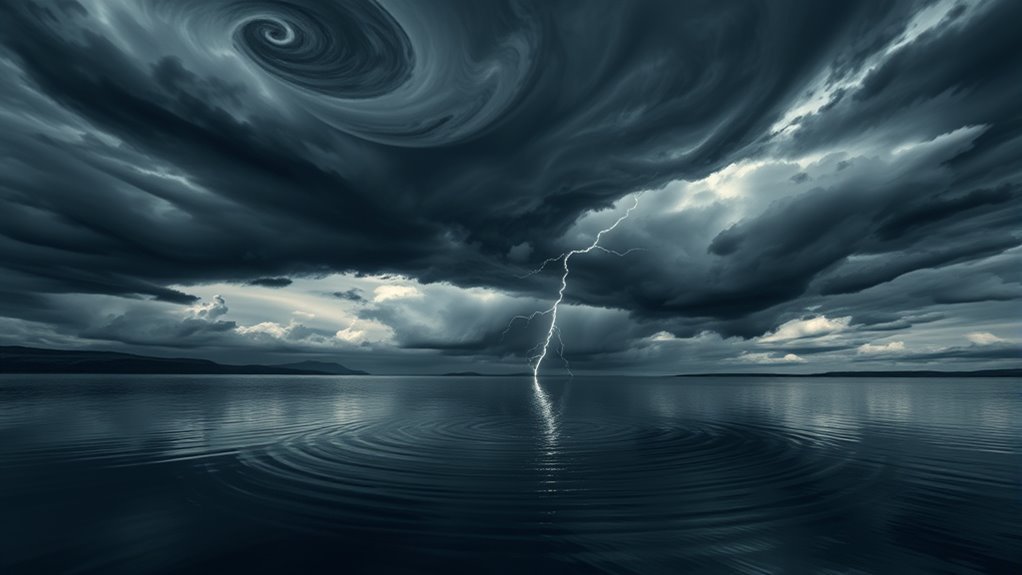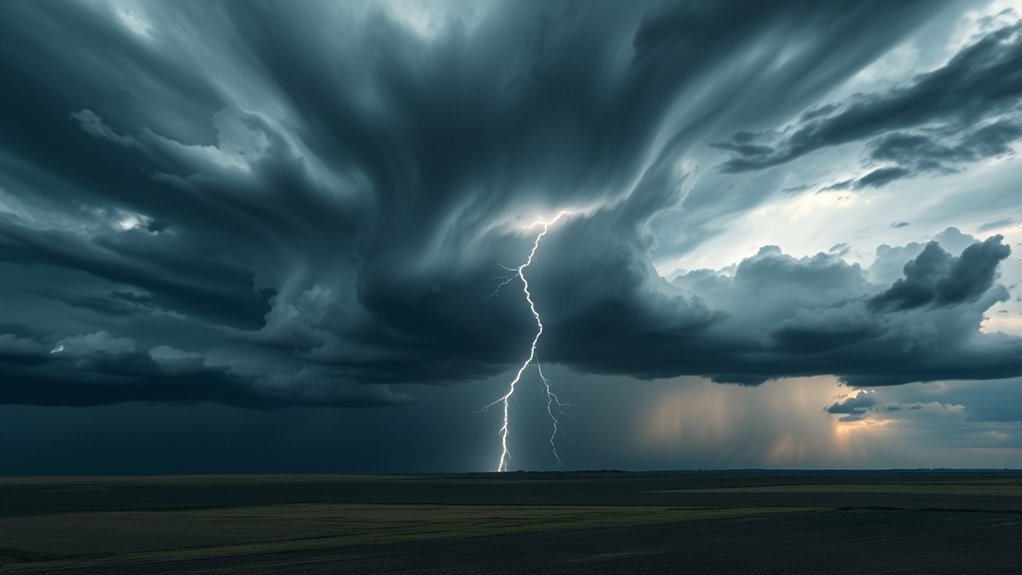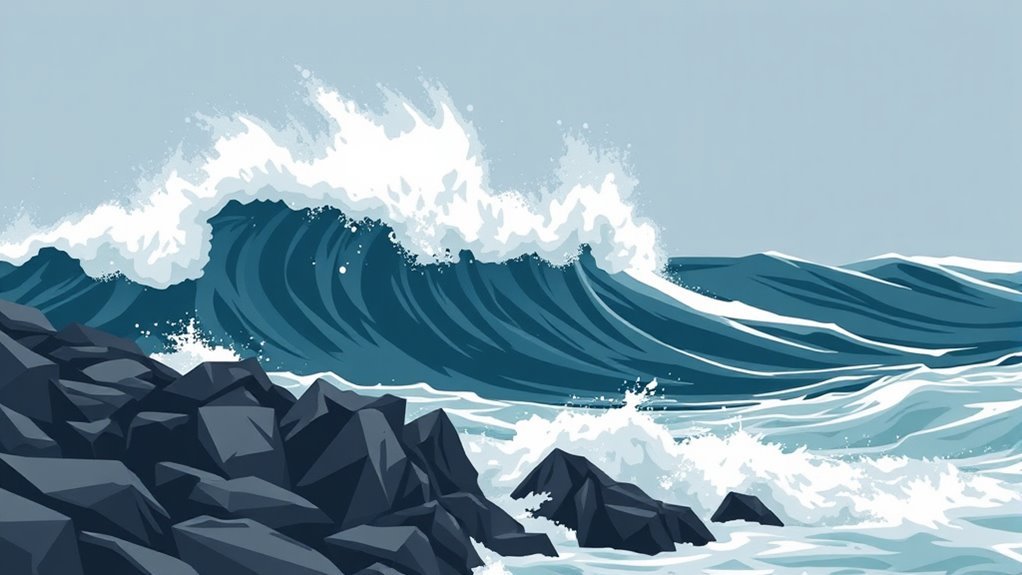Squalls are sudden weather events marked by rapid increases in wind speed and precipitation, often associated with convective clouds. They arise from warm, moist air rising over cooler surfaces. Recognizable by heavy rain and gusty winds, squalls can lead to hazardous conditions, especially at sea and on roads. Key meteorological indicators include strong wind shifts and decreases in atmospheric pressure. Understanding squalls is essential, and further perspectives on their impacts and forecasting methods await exploration.
Main Points
- Squalls are characterized by sudden increases in wind speed, heavy rain, and thunderstorms, often leading to hazardous conditions.
- They primarily form through rapid convection of warm, moist air, influenced by surface temperature variations and cold fronts.
- Meteorological indicators include rapid wind shifts, decreased atmospheric pressure, and the presence of towering cumulus or cumulonimbus clouds.
- Accurate forecasting relies on advanced radar technology, satellite imagery, and Doppler radar for real-time weather monitoring.
- Squalls significantly impact various industries, necessitating risk mitigation strategies and effective public communication for timely responses.
Definition and Characteristics of Squalls
Squalls are defined as sudden, sharp increases in wind speed, often accompanied by precipitation. These meteorological phenomena typically occur within convective clouds and can manifest quickly, sometimes within minutes.
The intensity of squalls can lead to hazardous conditions, especially at sea, where sailors may experience abrupt changes in wind direction and force. Characteristically, squalls can produce heavy rain, gusty winds, and even thunderstorms, resulting in reduced visibility and difficult navigation.
They are often categorized by their short duration, generally lasting from a few minutes to an hour. The temperature drop associated with squalls can also be considerable, leading to rapid changes in the surrounding environment.
Due to their unpredictable nature, squalls pose risks to both aviation and maritime operations, necessitating timely warnings and preparedness measures. Understanding their characteristics is essential for safety and effective weather forecasting.
Formation Processes of Squalls

While various meteorological factors contribute to the formation of squalls, they primarily arise from the rapid convection of warm, moist air. This process occurs when the surface temperature increases, causing air to rise quickly. As the warm air ascends, it cools and condenses, forming cumulus clouds, which can develop into more organized storm systems.
The presence of a front, particularly cold fronts, further improves this process by providing a lifting mechanism for the warm air.
Wind shear, or the change in wind speed and direction with altitude, also plays a vital role by creating turbulence and promoting the organization of convective cells.
Additionally, localized geographic features, such as mountains or bodies of water, can influence airflow patterns, aiding in the development of squalls.
In the end, the interplay of these factors leads to the creation of intense short-lived weather phenomena distinguished by strong winds and precipitation.
Types of Squalls: A Closer Look
Understanding the types of squalls is essential for comprehending their behavior and impacts.
Two primary categories are warm front squalls and cold front squalls, each defined by distinct atmospheric conditions.
An examination of these types reveals how they influence weather patterns and contribute to severe weather events.
Warm Front Squalls
As warm air rises over a colder surface, the interaction can lead to the formation of warm front squalls, which are defined by sudden increases in wind and precipitation.
These squalls typically occur when a warm air mass moves over a cooler one, resulting in the development of unstable atmospheric conditions.
The precipitation associated with warm front squalls is often steady and can vary in intensity, but the squalls themselves are marked by rapid shifts in wind direction and strength.
The changeover zone between the warm and cold air masses creates lift, leading to cloud formation and potential thunderstorms.
Consequently, warm front squalls can pose risks to aviation and maritime activities, necessitating careful monitoring by meteorologists.
Cold Front Squalls
Cold front squalls represent a remarkable meteorological phenomenon defined by abrupt changes in weather conditions. Typically associated with the leading edge of a cold front, these squalls occur when cold air rapidly displaces warm, moist air.
This process can generate intense thunderstorms, marked by heavy rainfall, strong winds, and sometimes hail. The shift can be dramatic, resulting in temperature drops and alterations in wind direction.
Cold front squalls often lead to reduced visibility and hazardous conditions for aviation and maritime operations. Meteorologists monitor these events closely, as they can develop quickly and pose considerable risks.
Understanding the dynamics of cold front squalls is essential for predicting severe weather and ensuring public safety during such occurrences.
Meteorological Indicators of Squalls

Squalls, marked by sudden and intense wind shifts, often present distinct meteorological indicators that can signal their approach. One key indicator is the rapid increase in wind speed, often accompanied by a shift in wind direction. This change can be detected through local weather stations or observations from mariners.
Additionally, a decrease in atmospheric pressure is frequently noted, indicating that a squall system is moving in.
Cloud formations also serve as crucial indicators; the presence of towering cumulus or cumulonimbus clouds may suggest the development of a squall.
Moreover, sudden changes in temperature and humidity levels can precede squall events, creating unstable atmospheric conditions.
Finally, radar imagery can reveal the formation of intense precipitation and storm cells, which often correlate with squall activity. Recognizing these indicators is essential for timely warnings and preparedness.
Impact of Squalls on Different Industries

The approach of squalls can have considerable ramifications across various industries, particularly those reliant on weather conditions.
In agriculture, sudden wind shifts and heavy rainfall can damage crops and disrupt harvesting schedules, leading to financial losses.
The construction sector faces challenges as squalls can halt operations, endanger workers, and delay project timelines.
In maritime operations, squalls pose major risks for shipping and fishing, causing hazardous conditions that can result in accidents or damage to vessels.
The airline industry is also affected, as squalls may lead to flight delays and cancellations, impacting schedules and passenger safety.
Moreover, the energy sector can experience disruptions in both production and distribution, particularly in wind and solar energy, where sudden changes in weather can affect output.
Altogether, understanding the impact of squalls is vital for industries to develop strategies that mitigate risks and improve resilience.
Safety Precautions During Squall Events
During squall events, individuals are advised to remain indoors and secure their surroundings to minimize risks.
It is also vital to stay updated by monitoring weather alerts, as conditions can change rapidly.
Implementing these safety precautions is essential for ensuring personal safety during severe weather.
Stay Indoors and Secure
Severe weather events, such as squalls, often prompt the need for immediate safety precautions. Individuals are advised to stay indoors during these occurrences to minimize exposure to potentially dangerous winds and debris.
Securing windows and doors is vital, as strong gusts can shatter glass or displace unsecured items. It is also recommended to avoid using elevators, as power outages may occur.
Those in mobile homes or temporary structures should seek more stable shelter, such as a basement or designated storm shelter. Additionally, keeping emergency supplies, including food, water, and first aid kits, readily available improves safety during squall events.
Remaining informed and prepared is essential for personal safety until the weather stabilizes.
Monitor Weather Alerts
Monitoring weather alerts is essential when squalls are forecasted, as timely information can greatly improve safety. Alerts issued by meteorological authorities provide critical updates on impending squalls, including severity and expected duration.
Individuals should utilize multiple sources for weather information, such as local news, weather apps, and NOAA radio, to guarantee they receive the latest warnings. As squalls can develop rapidly, staying informed allows for timely preparation and response.
It is advisable to pay attention to any changes in weather conditions, especially wind shifts and sudden temperature decreases. By prioritizing the monitoring of weather alerts, individuals can make informed decisions, seek shelter, and minimize risks associated with squall events, ultimately enhancing their safety and that of others.
Forecasting and Monitoring Squalls
Although squalls can develop rapidly, accurate forecasting and monitoring are imperative for mitigating their potential impacts. Meteorologists utilize advanced radar technology and satellite imagery to detect the formation of squall lines and their movement.
Doppler radar plays an essential role by providing real-time data on wind patterns, precipitation intensity, and storm structure.
Forecast models, including numerical weather prediction systems, help identify the atmospheric conditions conducive to squall development. Meteorologists analyze factors such as temperature, humidity, and wind shear to anticipate squall formation.
Additionally, monitoring weather alerts and advisories enables timely communication to the public, allowing individuals and organizations to prepare for severe weather.
Collaboration with emergency services ensures that response strategies are in place to address the hazards associated with squalls. Continuous observation and analysis are fundamental for enhancing the accuracy of forecasts and minimizing the risks posed by these sudden weather events.
Common Questions
How Do Squalls Differ From Thunderstorms?
Squalls primarily involve sudden, strong winds and brief heavy precipitation, while thunderstorms include lightning, thunder, and various forms of precipitation. Their dynamic nature differentiates squalls from the more complex structure of thunderstorms.
Can Squalls Occur in Winter?
Squalls can indeed occur in winter. These sudden wind shifts and intense precipitation events may arise from cold fronts or other meteorological conditions, impacting visibility and creating hazardous travel situations during the colder months.
What Is the Average Duration of a Squall?
The average duration of a squall typically lasts between 20 minutes to an hour. Variations may occur depending on environmental conditions, but most squalls exhibit a brief yet intense period of adverse weather phenomena.
Are Squalls Predictable Long-Term?
The predictability of squalls over the long term remains limited. Meteorologists often find it challenging to forecast their occurrence accurately due to the short-lived and localized nature of these weather phenomena, complicating long-range predictions.
What Role Do Squalls Play in Climate Change?
Squalls contribute to localized weather patterns, influencing precipitation and temperature fluctuations. Their intensity and frequency may be affected by climate change, potentially leading to increased severity and unpredictability in storm systems, thereby impacting regional climates.

